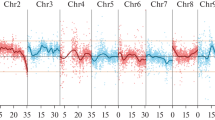Abstract
Resistance to submergence stress is an important breeding objective in areas where rice cultivars are subjected to complete inundation for a week or more. The present study was conducted to develop a high-resolution map of the region surrounding the submergence tolerance gene Sub1 in rice, which derives from the Indian cultivar FR13A. Submergence screening of 8-day-old plants of F3 families kept for 14 days submerged in 60 cm of water allowed an accurate classification of Sub1 phenotypes. Bulked segregant analysis was used to identify AFLP markers linked to Sub1. A population of 2950 F2 plants segregating for Sub1 was screened with two RFLP markers flanking the Sub1 locus, 2.4 and 4.9 cM away. Submergence tolerance was measured in the recombinant plants, and AFLP markers closely linked to Sub1 were mapped. Two AFLP markers cosegregated with Sub1 in this large population, and other markers were localized within 0.2 cM of Sub1. The high-resolution map should serve as the basis for map-based cloning of this important locus, as it will permit the identification of BAC clones spanning the region.
Similar content being viewed by others
Author information
Authors and Affiliations
Additional information
Received: 15 December 1999 / Accepted: 18 February 2000
Rights and permissions
About this article
Cite this article
Xu, K., Xu, X., Ronald, P. et al. A high-resolution linkage map of the vicinity of the rice submergence tolerance locus Sub1 . Mol Gen Genet 263, 681–689 (2000). https://doi.org/10.1007/s004380051217
Issue Date:
DOI: https://doi.org/10.1007/s004380051217




